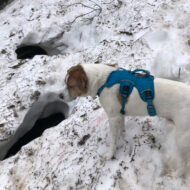Box breathing, also known as square breathing, is a powerful technique for managing anxiety. I first introduced it on my blog in December of 2022. Since then, I’ve shared it with coaching clients. It can be quite simple to pause, take a few moments, and calm ourselves whenever we’re stressed. The key is to know the technique and practice it. If you struggle with being anxious, stressed, fearful, or nervous, try it for yourself by following our YouTube video on box breathing. You can also read more about it.
Notice and Name
As you try the box breathing technique demonstrated above in our box breathing video, notice what you feel. Perhaps you feel a shift in mental clarity. Or physical relaxation, including loosening the shoulders or an urge to do some neck rolls. Maybe you feel increased safety or comfort.
If not, remember that mastering any new skill takes practice and repetition. For future practice, try making the exhale take 6 counts instead of 4. Longer exhales are especially helpful for the vagal nerve.
If you did feel something shifted, congratulations! You’ve just learned a powerful tool for resetting yourself whenever you feel anxious.

How Box Breathing Regulates Our Stress Response
Why is Box Breathing so effective? It helps regulate the body’s stress response in several ways.
Encourages Deep Breathing
Box breathing shifts us from a sympathetic (i.e. fight, flight, freeze, or flee) to a parasympathetic (rest and digest) state. We evolved with both. In today’s society, many of us have chronic stress. Try reminding yourself that there is no tiger in the room, no fire to put out, no mammoth at your doorstep.
Deep box breathing increases the supply of oxygen to our brain and stimulates the parasympathetic nervous system, which promotes calmness. We are in a much better position to make important decisions when we are calm. We also are much easier to get along with!

Focuses the Mind
Focusing on the simple act of counting helps distract us from anxious thoughts. Counting to four (on the inhale, hold, exhale, and hold, four times for each) provides a simple meditation practice that only takes a few minutes, is free, and is available to everyone at any time.
Such mental focus can quiet the mind, offering a much-needed break from stressors. It therefore helps to reduce our anxiety. It also produces harmony between the mind and body, leading to inner calm as you become more present and engaged with what your body is feeling.

Finally, practicing box breathing can reduce the production of stress hormones like cortisol, fostering relaxation and reducing anxiety levels.
Box Breathing Improves Physiological Functions
In addition to lowering our blood pressure and providing an immediate sense of calm, box breathing also improves the balance of oxygen and carbon dioxide in the blood. Why is this balance so important? Chat GPT helped me understand two situations that could happen when we are no longer in balance.

Hyperventilation (Excess Oxygen, Reduced Carbon Dioxide)
During hyperventilation, you breathe out carbon dioxide faster than your body produces it. This leads to a decrease in carbon dioxide levels in the blood, a condition known as hypocapnia. Symptoms include light-headedness, dizziness, shortness of breath, and sometimes tingling in the hands and feet.
Hypocapnia can lead to a constriction of the blood vessels that supply blood to the brain, reducing oxygen delivery to the brain despite high oxygen levels in the blood. This can cause fainting or anxiety symptoms.
The next time you are hyperventilating or feel so angry you could punch a hole in the wall, stop to take some deep box breaths, and see if you can get your blood oxygen levels back in balance.

Hypoventilation (Reduced Oxygen, Excess Carbon Dioxide)
The reverse, hypoventilation, occurs when breathing is too shallow or too slow, leading to an increase in carbon dioxide because it’s not being expelled at a normal rate. This can lead to hypercapnia, an excessive buildup of carbon dioxide in the blood.
Symptoms include confusion, fatigue, headaches, shortness of breath, and flushed skin. In severe cases, hypercapnia can lead to respiratory acidosis, where the blood becomes too acidic, which can be life-threatening if not treated.
One of the advantages of knowing how to perform pressure breathing at altitude, which we’ll share in a future post, is to expel that built-up carbon dioxide to make more room for more oxygen.

Box Breathing Takeaways
In summary, if you are looking for a way to help manage stress and anxiety, explore box breathing. You can do it multiple times a day. It is free and readily accessible to everyone. And it is easy to learn. Try the video above and see how it works for you.
And if you’d like to share your experience, please comment below. I love hearing from readers and your comments might help others. Breathe deeply. Breathe well. And keep breathing.

